Assyrian/Chaldean/Syriac vs Immigrants from Syria Community Comparison
COMPARE
Assyrian/Chaldean/Syriac
Immigrants from Syria
Social Comparison
Social Comparison
Assyrians/Chaldeans/Syriacs
Immigrants from Syria
7,301
SOCIAL INDEX
70.5/ 100
SOCIAL RATING
124th/ 347
SOCIAL RANK
5,570
SOCIAL INDEX
53.2/ 100
SOCIAL RATING
173rd/ 347
SOCIAL RANK
Immigrants from Syria Integration in Assyrian/Chaldean/Syriac Communities
The statistical analysis conducted on geographies consisting of 79,972,562 people shows a weak positive correlation between the proportion of Immigrants from Syria within Assyrian/Chaldean/Syriac communities in the United States with a correlation coefficient (R) of 0.226. On average, for every 1% (one percent) increase in Assyrians/Chaldeans/Syriacs within a typical geography, there is an increase of 0.028% in Immigrants from Syria. To illustrate, in a geography comprising of 100,000 individuals, a rise of 1,000 Assyrians/Chaldeans/Syriacs corresponds to an increase of 27.8 Immigrants from Syria.
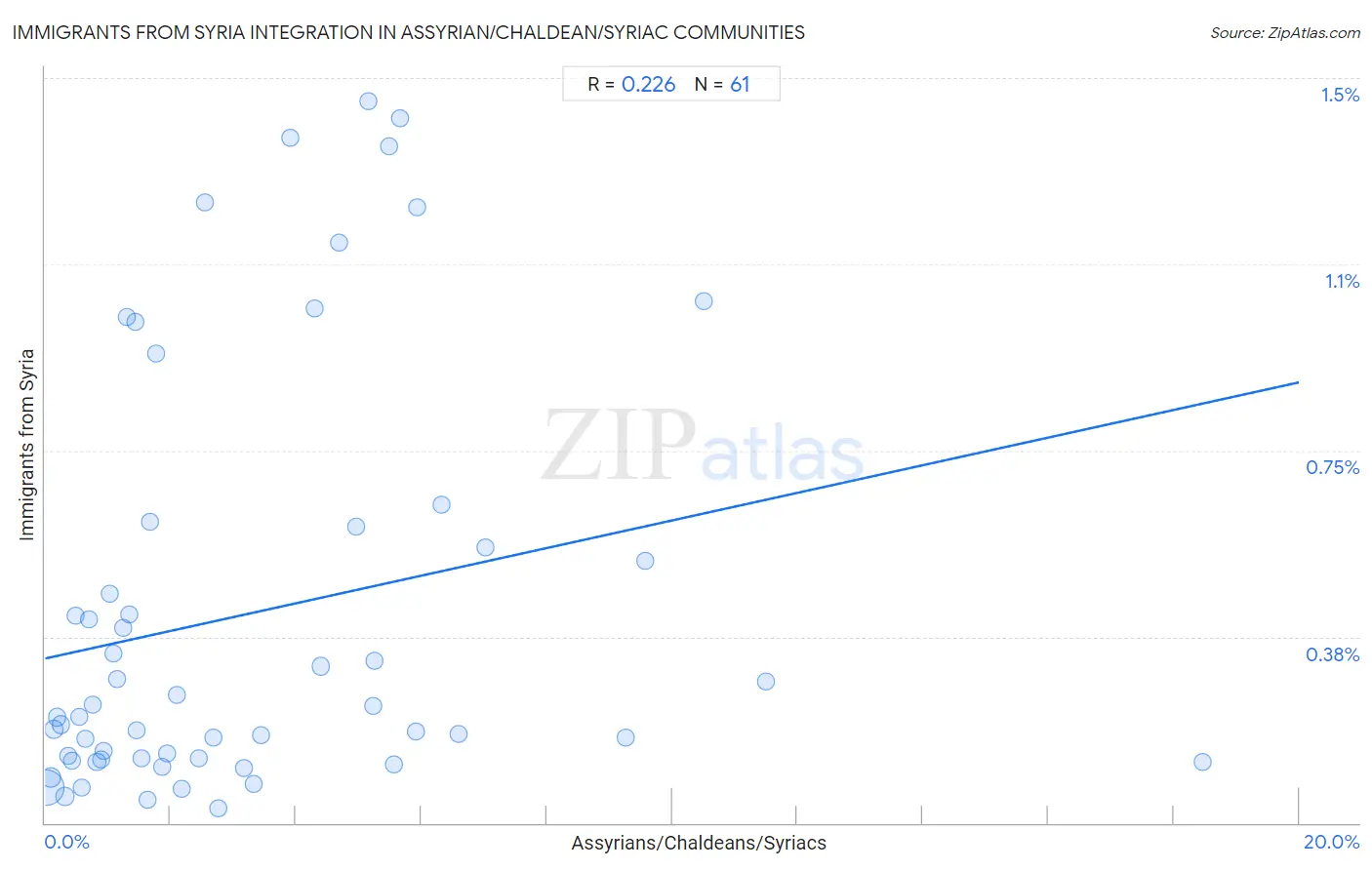
Assyrian/Chaldean/Syriac vs Immigrants from Syria Income
When considering income, the most significant differences between Assyrian/Chaldean/Syriac and Immigrants from Syria communities in the United States are seen in householder income under 25 years ($65,329 compared to $51,494, a difference of 26.9%), wage/income gap (31.0% compared to 26.4%, a difference of 17.5%), and householder income ages 25 - 44 years ($101,936 compared to $96,789, a difference of 5.3%). Conversely, both communities are more comparable in terms of per capita income ($45,195 compared to $45,218, a difference of 0.050%), median earnings ($48,304 compared to $48,375, a difference of 0.15%), and median male earnings ($58,437 compared to $56,830, a difference of 2.8%).

| Income Metric | Assyrian/Chaldean/Syriac | Immigrants from Syria |
| Per Capita Income | Excellent $45,195 | Excellent $45,218 |
| Median Family Income | Exceptional $109,622 | Excellent $106,118 |
| Median Household Income | Exceptional $91,991 | Exceptional $88,792 |
| Median Earnings | Exceptional $48,304 | Exceptional $48,375 |
| Median Male Earnings | Exceptional $58,437 | Exceptional $56,830 |
| Median Female Earnings | Fair $39,159 | Excellent $40,499 |
| Householder Age | Under 25 years | Exceptional $65,329 | Poor $51,494 |
| Householder Age | 25 - 44 years | Exceptional $101,936 | Good $96,789 |
| Householder Age | 45 - 64 years | Exceptional $110,201 | Exceptional $104,858 |
| Householder Age | Over 65 years | Exceptional $64,108 | Excellent $62,303 |
| Wage/Income Gap | Tragic 31.0% | Poor 26.4% |
Assyrian/Chaldean/Syriac vs Immigrants from Syria Poverty
When considering poverty, the most significant differences between Assyrian/Chaldean/Syriac and Immigrants from Syria communities in the United States are seen in female poverty among 18-24 year olds (13.7% compared to 19.2%, a difference of 40.3%), single father poverty (11.7% compared to 15.9%, a difference of 35.6%), and single male poverty (9.8% compared to 12.4%, a difference of 27.1%). Conversely, both communities are more comparable in terms of receiving food stamps (10.6% compared to 11.7%, a difference of 10.2%), married-couple family poverty (4.9% compared to 5.5%, a difference of 11.9%), and seniors poverty over the age of 75 (10.7% compared to 12.2%, a difference of 13.5%).
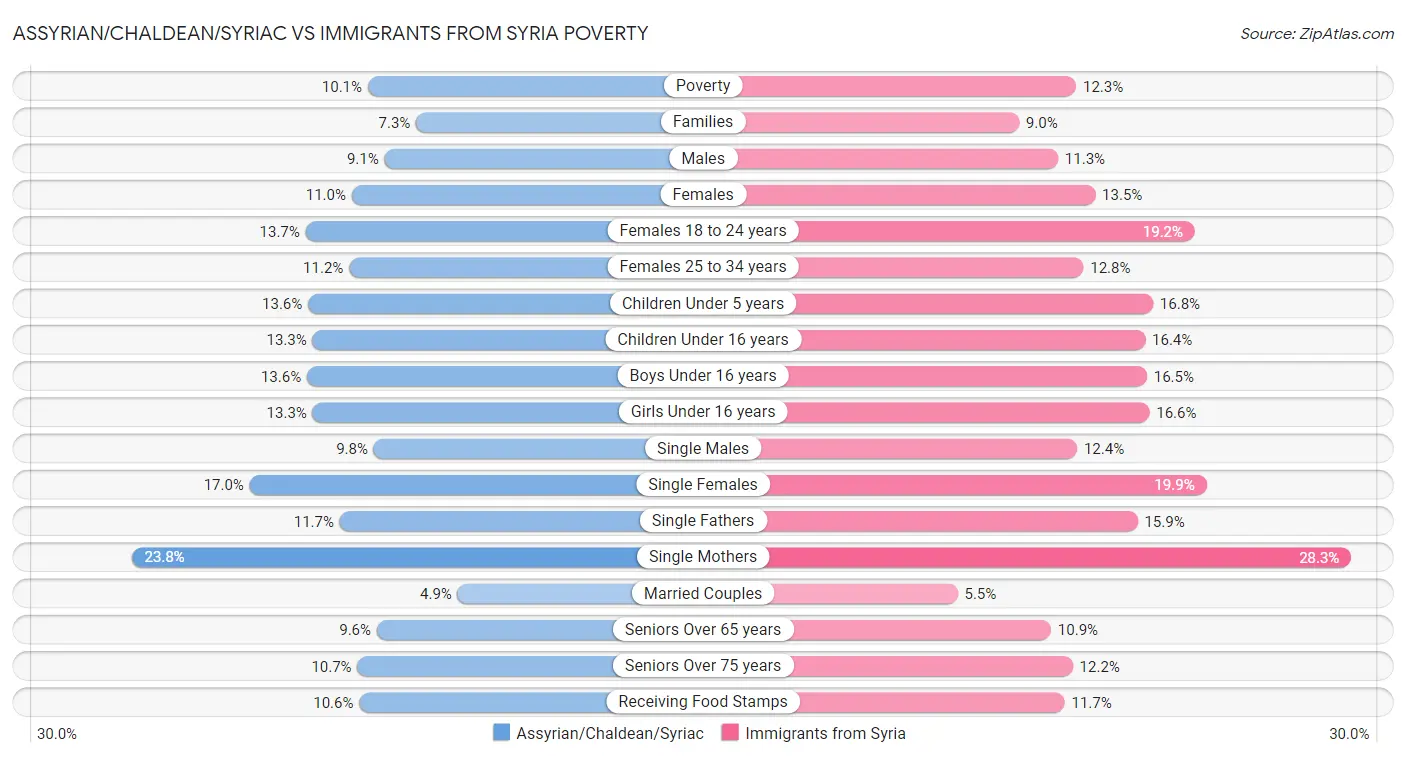
| Poverty Metric | Assyrian/Chaldean/Syriac | Immigrants from Syria |
| Poverty | Exceptional 10.1% | Average 12.3% |
| Families | Exceptional 7.3% | Average 9.0% |
| Males | Exceptional 9.1% | Average 11.3% |
| Females | Exceptional 11.0% | Average 13.5% |
| Females 18 to 24 years | Exceptional 13.7% | Exceptional 19.2% |
| Females 25 to 34 years | Exceptional 11.2% | Exceptional 12.8% |
| Children Under 5 years | Exceptional 13.6% | Good 16.8% |
| Children Under 16 years | Exceptional 13.3% | Average 16.4% |
| Boys Under 16 years | Exceptional 13.6% | Average 16.5% |
| Girls Under 16 years | Exceptional 13.3% | Average 16.6% |
| Single Males | Exceptional 9.8% | Exceptional 12.4% |
| Single Females | Exceptional 17.0% | Exceptional 19.9% |
| Single Fathers | Exceptional 11.7% | Excellent 15.9% |
| Single Mothers | Exceptional 23.8% | Exceptional 28.3% |
| Married Couples | Excellent 4.9% | Poor 5.5% |
| Seniors Over 65 years | Exceptional 9.6% | Average 10.9% |
| Seniors Over 75 years | Exceptional 10.7% | Average 12.2% |
| Receiving Food Stamps | Exceptional 10.6% | Average 11.7% |
Assyrian/Chaldean/Syriac vs Immigrants from Syria Unemployment
When considering unemployment, the most significant differences between Assyrian/Chaldean/Syriac and Immigrants from Syria communities in the United States are seen in unemployment among seniors over 75 years (11.1% compared to 8.0%, a difference of 38.9%), unemployment among women with children ages 6 to 17 years (7.2% compared to 9.1%, a difference of 25.6%), and unemployment among women with children under 6 years (6.5% compared to 7.8%, a difference of 21.3%). Conversely, both communities are more comparable in terms of female unemployment (5.6% compared to 5.6%, a difference of 0.060%), unemployment among ages 16 to 19 years (17.9% compared to 18.0%, a difference of 0.62%), and unemployment among ages 45 to 54 years (4.7% compared to 4.8%, a difference of 1.5%).
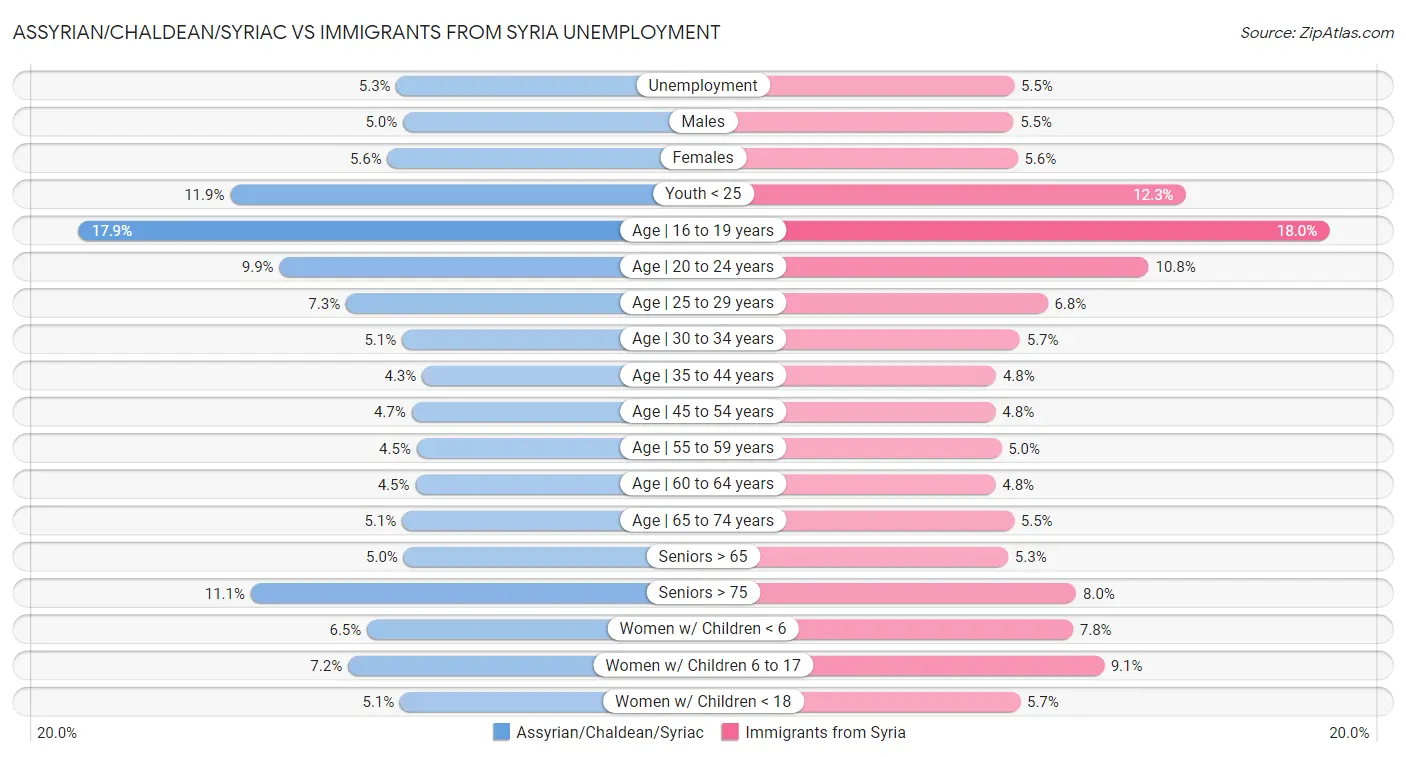
| Unemployment Metric | Assyrian/Chaldean/Syriac | Immigrants from Syria |
| Unemployment | Fair 5.3% | Tragic 5.5% |
| Males | Exceptional 5.0% | Tragic 5.5% |
| Females | Tragic 5.6% | Tragic 5.6% |
| Youth < 25 | Tragic 11.9% | Tragic 12.3% |
| Age | 16 to 19 years | Fair 17.9% | Poor 18.0% |
| Age | 20 to 24 years | Exceptional 9.9% | Tragic 10.8% |
| Age | 25 to 29 years | Tragic 7.3% | Poor 6.8% |
| Age | 30 to 34 years | Exceptional 5.1% | Tragic 5.7% |
| Age | 35 to 44 years | Exceptional 4.3% | Fair 4.8% |
| Age | 45 to 54 years | Tragic 4.7% | Tragic 4.8% |
| Age | 55 to 59 years | Exceptional 4.5% | Tragic 5.0% |
| Age | 60 to 64 years | Exceptional 4.5% | Exceptional 4.8% |
| Age | 65 to 74 years | Exceptional 5.1% | Tragic 5.5% |
| Seniors > 65 | Exceptional 5.0% | Tragic 5.3% |
| Seniors > 75 | Tragic 11.1% | Exceptional 8.0% |
| Women w/ Children < 6 | Exceptional 6.5% | Poor 7.8% |
| Women w/ Children 6 to 17 | Exceptional 7.2% | Fair 9.1% |
| Women w/ Children < 18 | Exceptional 5.1% | Tragic 5.7% |
Assyrian/Chaldean/Syriac vs Immigrants from Syria Labor Participation
When considering labor participation, the most significant differences between Assyrian/Chaldean/Syriac and Immigrants from Syria communities in the United States are seen in in labor force | age 16-19 (38.3% compared to 35.2%, a difference of 9.0%), in labor force | age 20-24 (75.9% compared to 74.0%, a difference of 2.5%), and in labor force | age > 16 (64.0% compared to 65.3%, a difference of 2.0%). Conversely, both communities are more comparable in terms of in labor force | age 20-64 (79.4% compared to 79.4%, a difference of 0.020%), in labor force | age 35-44 (84.0% compared to 83.9%, a difference of 0.17%), and in labor force | age 25-29 (84.7% compared to 84.3%, a difference of 0.39%).

| Labor Participation Metric | Assyrian/Chaldean/Syriac | Immigrants from Syria |
| In Labor Force | Age > 16 | Tragic 64.0% | Good 65.3% |
| In Labor Force | Age 20-64 | Fair 79.4% | Fair 79.4% |
| In Labor Force | Age 16-19 | Exceptional 38.3% | Tragic 35.2% |
| In Labor Force | Age 20-24 | Exceptional 75.9% | Tragic 74.0% |
| In Labor Force | Age 25-29 | Average 84.7% | Poor 84.3% |
| In Labor Force | Age 30-34 | Tragic 83.2% | Fair 84.5% |
| In Labor Force | Age 35-44 | Tragic 84.0% | Tragic 83.9% |
| In Labor Force | Age 45-54 | Exceptional 83.2% | Tragic 82.3% |
Assyrian/Chaldean/Syriac vs Immigrants from Syria Family Structure
When considering family structure, the most significant differences between Assyrian/Chaldean/Syriac and Immigrants from Syria communities in the United States are seen in births to unmarried women (22.0% compared to 29.4%, a difference of 33.6%), single mother households (4.8% compared to 6.2%, a difference of 28.6%), and single father households (2.0% compared to 2.3%, a difference of 15.5%). Conversely, both communities are more comparable in terms of average family size (3.24 compared to 3.26, a difference of 0.56%), family households with children (28.1% compared to 28.4%, a difference of 0.93%), and family households (68.2% compared to 65.2%, a difference of 4.6%).

| Family Structure Metric | Assyrian/Chaldean/Syriac | Immigrants from Syria |
| Family Households | Exceptional 68.2% | Exceptional 65.2% |
| Family Households with Children | Exceptional 28.1% | Exceptional 28.4% |
| Married-couple Households | Exceptional 51.8% | Excellent 47.1% |
| Average Family Size | Good 3.24 | Exceptional 3.26 |
| Single Father Households | Exceptional 2.0% | Excellent 2.3% |
| Single Mother Households | Exceptional 4.8% | Good 6.2% |
| Currently Married | Exceptional 50.8% | Average 46.8% |
| Divorced or Separated | Exceptional 10.6% | Exceptional 11.4% |
| Births to Unmarried Women | Exceptional 22.0% | Exceptional 29.4% |
Assyrian/Chaldean/Syriac vs Immigrants from Syria Vehicle Availability
When considering vehicle availability, the most significant differences between Assyrian/Chaldean/Syriac and Immigrants from Syria communities in the United States are seen in no vehicles in household (7.0% compared to 9.6%, a difference of 38.3%), 4 or more vehicles in household (7.2% compared to 6.3%, a difference of 12.8%), and 3 or more vehicles in household (21.7% compared to 19.4%, a difference of 12.2%). Conversely, both communities are more comparable in terms of 1 or more vehicles in household (93.0% compared to 90.4%, a difference of 2.9%), 2 or more vehicles in household (60.5% compared to 56.2%, a difference of 7.8%), and 3 or more vehicles in household (21.7% compared to 19.4%, a difference of 12.2%).

| Vehicle Availability Metric | Assyrian/Chaldean/Syriac | Immigrants from Syria |
| No Vehicles Available | Exceptional 7.0% | Excellent 9.6% |
| 1+ Vehicles Available | Exceptional 93.0% | Excellent 90.4% |
| 2+ Vehicles Available | Exceptional 60.5% | Excellent 56.2% |
| 3+ Vehicles Available | Exceptional 21.7% | Average 19.4% |
| 4+ Vehicles Available | Exceptional 7.2% | Average 6.3% |
Assyrian/Chaldean/Syriac vs Immigrants from Syria Education Level
When considering education level, the most significant differences between Assyrian/Chaldean/Syriac and Immigrants from Syria communities in the United States are seen in doctorate degree (1.7% compared to 1.9%, a difference of 17.9%), professional degree (4.5% compared to 4.9%, a difference of 8.7%), and no schooling completed (2.5% compared to 2.3%, a difference of 7.7%). Conversely, both communities are more comparable in terms of 5th grade (97.0% compared to 97.1%, a difference of 0.040%), 4th grade (97.2% compared to 97.2%, a difference of 0.050%), and 6th grade (96.7% compared to 96.7%, a difference of 0.050%).
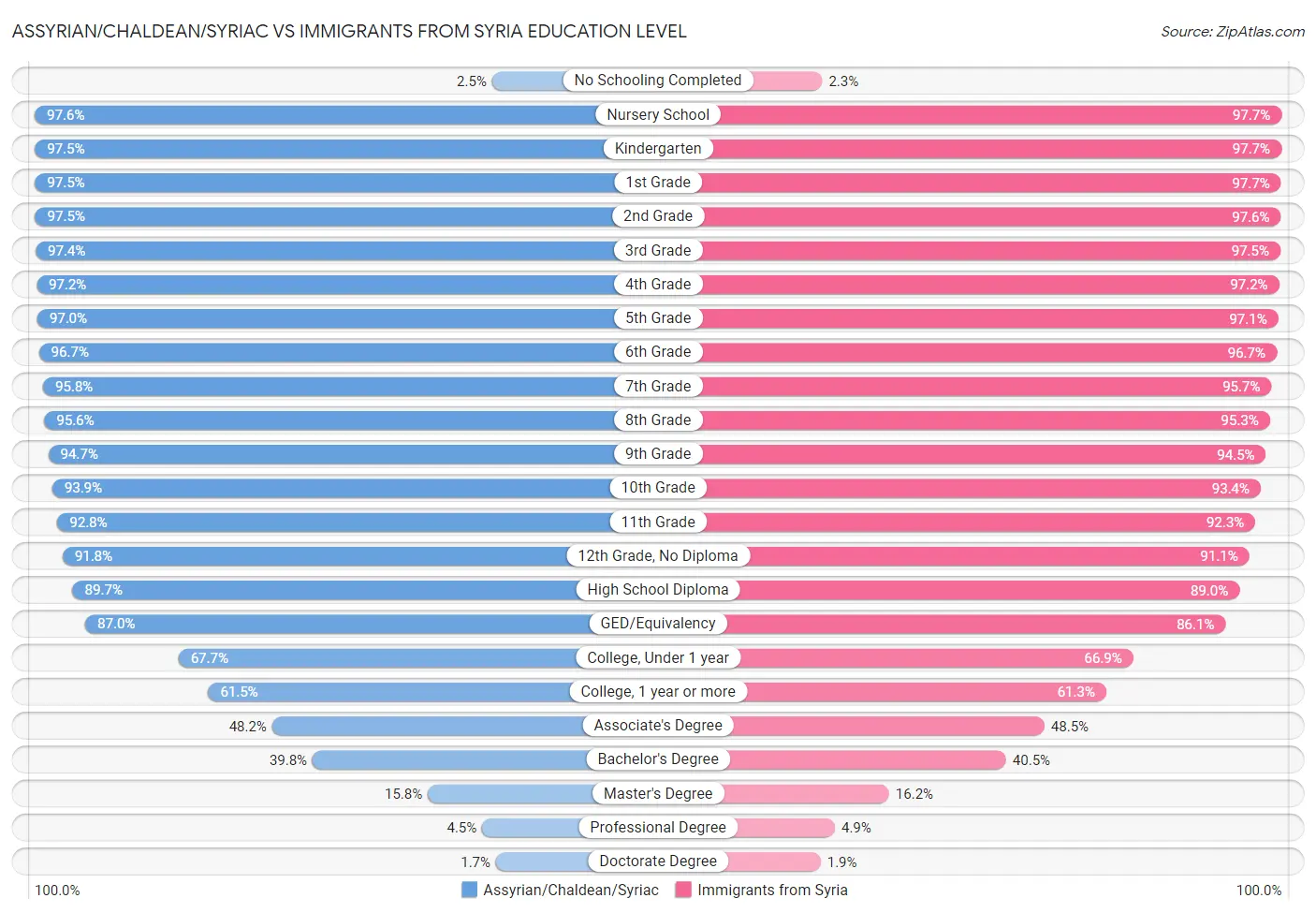
| Education Level Metric | Assyrian/Chaldean/Syriac | Immigrants from Syria |
| No Schooling Completed | Tragic 2.5% | Tragic 2.3% |
| Nursery School | Tragic 97.6% | Tragic 97.7% |
| Kindergarten | Tragic 97.5% | Tragic 97.7% |
| 1st Grade | Tragic 97.5% | Tragic 97.7% |
| 2nd Grade | Tragic 97.5% | Tragic 97.6% |
| 3rd Grade | Tragic 97.4% | Tragic 97.5% |
| 4th Grade | Tragic 97.2% | Tragic 97.2% |
| 5th Grade | Tragic 97.0% | Tragic 97.1% |
| 6th Grade | Tragic 96.7% | Tragic 96.7% |
| 7th Grade | Fair 95.8% | Tragic 95.7% |
| 8th Grade | Fair 95.6% | Tragic 95.3% |
| 9th Grade | Fair 94.7% | Poor 94.5% |
| 10th Grade | Good 93.9% | Poor 93.4% |
| 11th Grade | Excellent 92.8% | Fair 92.3% |
| 12th Grade, No Diploma | Excellent 91.8% | Average 91.1% |
| High School Diploma | Excellent 89.7% | Fair 89.0% |
| GED/Equivalency | Exceptional 87.0% | Good 86.1% |
| College, Under 1 year | Exceptional 67.7% | Excellent 66.9% |
| College, 1 year or more | Exceptional 61.5% | Exceptional 61.3% |
| Associate's Degree | Excellent 48.2% | Exceptional 48.5% |
| Bachelor's Degree | Excellent 39.8% | Exceptional 40.5% |
| Master's Degree | Excellent 15.8% | Exceptional 16.2% |
| Professional Degree | Good 4.5% | Exceptional 4.9% |
| Doctorate Degree | Tragic 1.7% | Excellent 1.9% |
Assyrian/Chaldean/Syriac vs Immigrants from Syria Disability
When considering disability, the most significant differences between Assyrian/Chaldean/Syriac and Immigrants from Syria communities in the United States are seen in hearing disability (3.3% compared to 2.9%, a difference of 15.9%), self-care disability (2.8% compared to 2.6%, a difference of 9.5%), and ambulatory disability (6.4% compared to 6.0%, a difference of 7.3%). Conversely, both communities are more comparable in terms of vision disability (2.0% compared to 2.1%, a difference of 1.2%), disability age 18 to 34 (6.1% compared to 6.2%, a difference of 1.7%), and disability age 35 to 64 (10.5% compared to 10.7%, a difference of 1.8%).
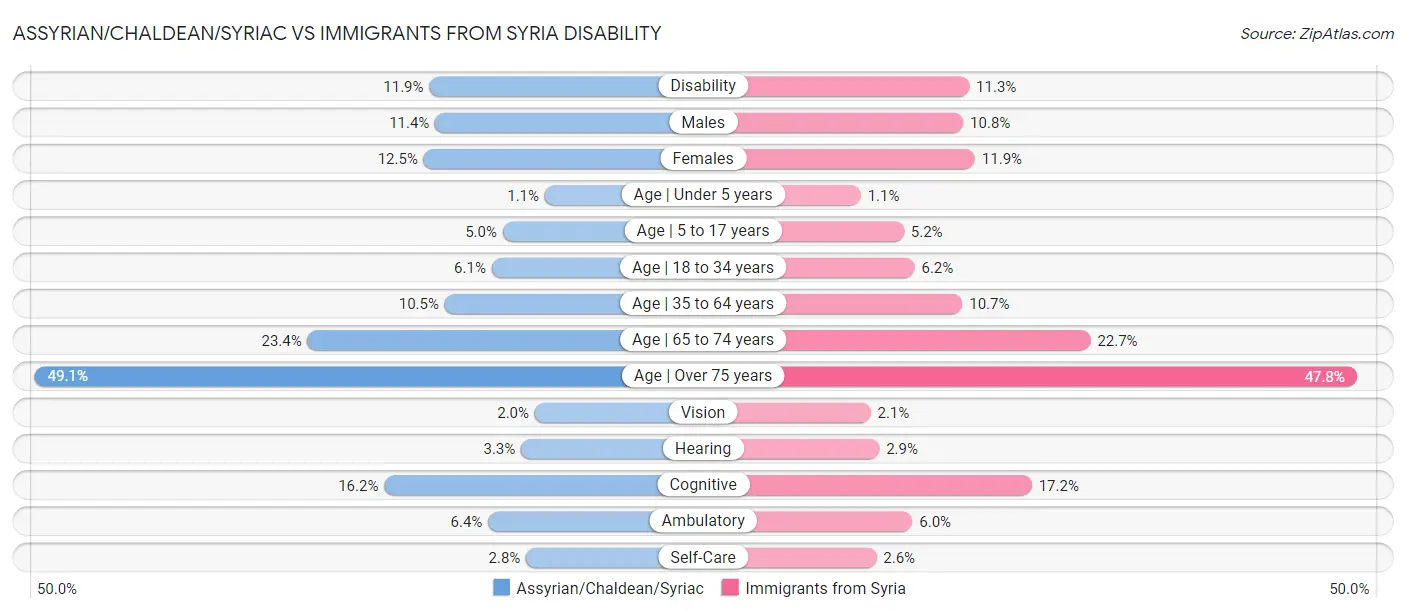
| Disability Metric | Assyrian/Chaldean/Syriac | Immigrants from Syria |
| Disability | Poor 11.9% | Exceptional 11.3% |
| Males | Fair 11.4% | Exceptional 10.8% |
| Females | Tragic 12.5% | Exceptional 11.9% |
| Age | Under 5 years | Exceptional 1.1% | Exceptional 1.1% |
| Age | 5 to 17 years | Exceptional 5.0% | Exceptional 5.2% |
| Age | 18 to 34 years | Exceptional 6.1% | Exceptional 6.2% |
| Age | 35 to 64 years | Exceptional 10.5% | Exceptional 10.7% |
| Age | 65 to 74 years | Average 23.4% | Excellent 22.7% |
| Age | Over 75 years | Tragic 49.1% | Poor 47.8% |
| Vision | Exceptional 2.0% | Exceptional 2.1% |
| Hearing | Tragic 3.3% | Excellent 2.9% |
| Cognitive | Exceptional 16.2% | Good 17.2% |
| Ambulatory | Tragic 6.4% | Excellent 6.0% |
| Self-Care | Tragic 2.8% | Tragic 2.6% |